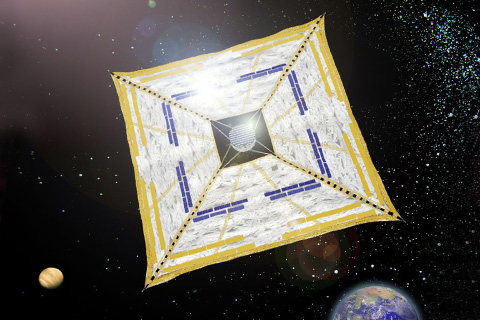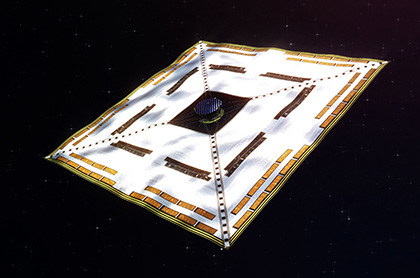About Small Solar Power Sail Demonstrator "IKAROS"
 |
Space yacht accelerated by radiation of the SunA Solar Sail gathers sunlight as propulsion by means of a large membrane while a Solar "Power" Sail gets electricity from thin film solar cells on the membrane in addition to acceleration by solar radiation. What's more, if the ion-propulsion engines with high specific impulse are driven by such solar cells, it can become a "hybrid" engine that is combined with photon acceleration to realize fuel-effective and flexible missions. Launch date: May 21, 2010 |
|---|
Project Topics
indexIKAROS enters hibernation mode for 5th time

|
JAXA has been confirming the status of the Small Solar Power Sail Demonstrator “IKAROS” by receiving data from it since April 2015, when the IKAROS woke up from its hibernation mode. We, however, could not receive radio waves from the IKAROS on May 21, thus we determined that the demonstrator had shifted to the hibernation mode for the fifth time as we expected. According to the last data acquired in May, the position of the IKAROS is about 110 million kilometers away from the Earth, and about... |
|---|
Press Release
index-
- July 14, 2010 (15:30)
- Small Solar Power Sail Demonstrator 'IKAROS' Successfully Observed Gamma-ray Burst
Characteristics of Small Solar Power Sail Demonstrator "IKAROS"
Vast, thin, and strong solar sail
|
A solar sail can move forward without consuming propellant as long as it can generate enough energy from sunlight. This idea was born some 100 years ago, but it had lots of technical hurdles such as the appropriate material and deployment method for the sail. Recently, we have finally seen some prospect of using this technology practically. The sail of the IKAROS is a huge square some 20 meters in a diagonal line, as thin as 0.0075 mm, and made from polyimide resin. On the membrane of the sail are not only thin film solar cells but also an Attitude Control device and scientific observation sensors. This thin and light solar sail membrane will be deployed using the centrifugal force of spinning the main body of the IKAROS before its tension is maintained. The deployment is in two stages. The first stage is carried out quasi-statically by the onboard deployment mechanism on the side of the main body. The second stage is the dynamic deployment. As this deployment method does not require a strut such as a boom, it can contribute to making it lighter, thus can be apply for a larger membrane. |

|
|---|
Major Characteristics
| International Designation Code | 2010-020E |
|---|---|
| Launch Date | 6:58, May 21, 2010 (JST) |
| Launch Vehicle | H-IIA Launch Vehicle No.17 |
| Location | Tanegashima Space Center |
| Configuration / Body | Diam. 1.6 m x Height 0.8 m (Cylinder shape) |
| Configuration / Membrane | Square of side 14 m and cross section 20 m (after deployment) |
| Weight | Mass at liftoff: about 310 kg |
Contents

- Mar. 5, 2010
- JAXA Explores the Planets of the Solar System